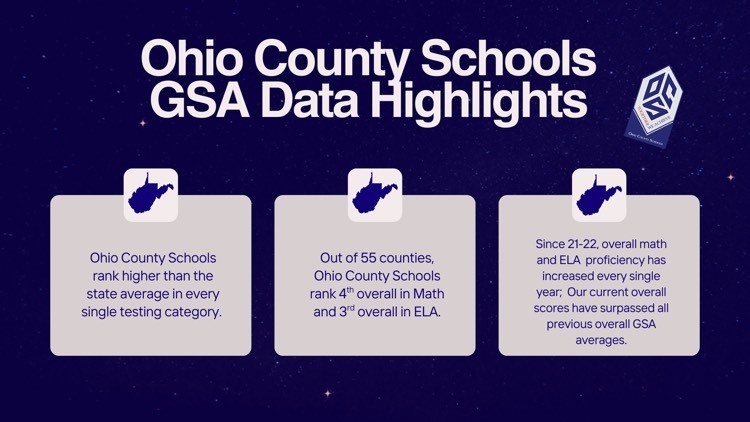Ohio County Schools: Growth and Consistency on the 2024-2025 WV GSA
On the afternoon of August 13th, Ohio County Schools Superintendent, Dr. Kim Miller, and members of the central office crowd around their annual August vision: large post it notes breaking down school specific testing information. They’re analyzing data, and overall, celebrating the achievements of students and staff on the 2024-2025 WV GSA. “Every year is a new chance for improvement,” states Miller.
Overall Data
Each spring, thousands of students partake in the WV General Summative Assessment, also known as the GSA. On August 13th, the testing embargo for the state lifted and our county scores will become available for our community. Ohio County Schools showed overall growth across both ELA and Math. “This specific state test is now in its 7th year of data collection,” states JoJo Shay, OCS Innovation Coordinator. This year’s data reports good news not only for Ohio County Schools, but for the state of WV as a whole. Overall data highlights? Ohio County Schools ranks 4th in the state for Math and 3rd in the state for ELA with nearly 50% of overall students exceeding or meeting math standards and nearly 60% of overall students exceeding or meeting ELA standards. Ohio County pulls 10% points above the state average in both ELA in Math. Both overall percentages have increased since last year’s test and our overall ELA score pulls the highest out of the Northern Panhandle. Every county in the top 10 has increased their overall scores. The state department reports that 48 out of 55 counties improved in math and 52 out of 55 counties showed improved proficiency in reading. As a state, we’re proud of WV.
The Staff
In the last few years, the system in which Ohio County Schools tracks testing data has been revamped, and our teachers have been instrumental in these shifts. “Several years ago, we shifted to a very specific method of tracking data, and we’ve maintained consistency. At this point in the process, our teachers are returning to the classroom with those numbers in hand for the students they will be teaching during the upcoming school year. They’re ready to hit the ground running!” explains Shay. “We also really need to recognize the countless hours our staff has put in whether through working on MAPping (data tracking using tools that align with the test) or having meaningful conversations at our Summer Data Summits,” states Federal Programs Director, Walt Saunders. The conversations our teachers have before, during, and after our state test are honest. They are student-centered and growth oriented.
The Students and The Plan
This year’s data is a story of consistency with highlighted growth spots across the state. In the elementary world, this is a direct result of a shift into Science of Reading Curriculum and WV’s Third Grade Success Act. We also know that the snapshot of our county does not live solely in data. Our media will report, as needed, on percent proficiency. This will give our community the percentage of students who are labeled as “proficient” at those specific standards in the grade level in which they are tested. It’s important to note that those reports will not necessarily show growth or break down which standards, particularly at the high school level, have not yet been taught. You will not hear about the student who has struggled for years to read on grade level and has consistently been labeled as “does not meet standards,” on the state test. That student however, through the help of a county interventionist, pure grit, and evidenced-based practices, achieved a “partially meets standards” for the first time this year. Whether growing from a “does not meet” to a “partially meets” or shifting from a “meets standards” to “exceeds standards,” we have hundreds and hundreds of students who have shown exceptional growth academically this year, and their stories are just as worthy of celebration and reporting, in fact, less than 14% and 22% of overall OCS ELA and Math scores are not meeting standards. There is already a plan in place for intervention as we head into the new school year including a mandated financial literacy course at the high school level. Plans, questions, and more information will be available during the 8/25 BOE meeting where Innovation Coordinator, JoJo Shay, will walk through the data and answer questions from the Board of Education. “There are no quick fixes,” states Shay, “But we CAN focus on long term fixes. We can focus on more kids having more skills.”

